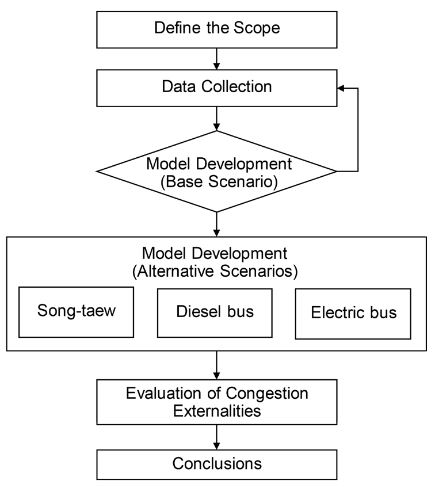Evaluation of Urban Traffic Congestion Externalities Induced by Chiang Mai Public Transit Systems
Keywords:
traffic congestion, public transport, energy, emission, traffic simulationAbstract
Traffic congestion in urban areas is one of the most pressing problems for urban transport policymakers in the nation. The urban traffic congestion not only inconveniences the users on roadways, but also affects the entire urban areas. The significances of congestion that have been considered are the increase of travel time, fuel consumption, traffic accidents, and environmental pollution. Public transport has been an alternative transport solution that helps manage the travel demand and reduce traffic congestion in urban areas. This study aims to propose the analytical framework to evaluate congestion externalities induced by road transport under different public transit scenarios being planned in 2017 Chiang Mai Public Transit Master Plan (CMP-MAP). Three public transit systems were compared: conventional transit vehicles (Song-taew), diesel buses, and electric buses. The study applied microscopic traffic simulation and emission models to evaluate the mobility performance, operating speed, air pollution, and energy consumption. The results showed that congestion externalities are affected by public transit modes. The proposed public buses either diesel-based or electric-based would reduce congestion externalities within a certain extent due to the reduction in private vehicles along the corridor. However, its cost-effectiveness and potentials should be further analyzed in detail.
Downloads
References
Abou-Senna, H., & Radwan, E. (2013). VISSIM/MOVES integration to investigate the effect of major key parameters on CO2 emissions. Transportation Research Part D: Transport and Environment, 21, 39-46.
Anh, K., Kronprasert, N., & Rakha, H. (2009). Energy and environmental assessment of high-speed roundabouts. Transportation Research Record: Journal of Transportation Research Boards, 2123, pp.54-65.
Bao, L., & Li, W. (2014). Study on Intersection Energy Consumption and Emissions under Various Bus Station Locations. COTA International Conference of Transportation Professionals, 14.
Blomgren, M., & Jungbjer, P. (2019). Emissions Modeling of Electric Urban Transit. Gothenburg: Chalmers University of Technology.
Elkafoury, A., NEGM, A. M., Bady, M. F., & Hafezaly, M. (2015). VISSIM based microscopic traffic emission prediction model. Alexandria: University of Alexandria.
Fukutomi, A. (2004). Simulation Approach to the Study of Driving Behaviour, Fuel Consumption, and Emission. Ottawa: Carleton University.
OECD. (2007). Managing Urban Traffic Congestion, Transport Research Centre, Organization for Economic Cooperation and Development.
OTP. (2017). Chiang Mai Public Transit Master Plan (CM- PMAP). Final Report, Office of Transport and Traffic Policy and Planning.
PTV Group. (2019).Emissions Modeling. Retrived December 15, 2019, from http://vision-traffic.ptvgroup.com/en-us/products/ptv-vissim/use-cases/emissions-modelling/
Quaassdorff, C., Borge, R., Pérez, J., Lumbreras, J., de la Paz, D., & de Andrés, J. M. (2016). Microscale traffic simulation and emission estimation in a heavily trafficked roundabout in Madrid (Spain). Science of The Total Environment, 566-567, 416-427.
Rakha, H., Anh, K., & Trani, A. (2004) Development of VT-Micro model for estimating hot stabilized light duty vehicle and truck emissions. Transportation Research Part D: Transport and Environment, 9, 49-74.
Stevanovic, A., Stevanovic, J., Zhang, K., & Batterman, S. (2009). Optimizing Traffic Control to Reduce Fuel Consumption and Vehicular Emissions Integrated Approach with VISSIM, CMEM, and VISGAOS. Transportation Research Board of the National Academies, 2128, 105-113.

Downloads
Published
How to Cite
Issue
Section
License
Copyright (c) 2019 International Journal of Building, Urban, Interior and Landscape Technology (BUILT)

This work is licensed under a Creative Commons Attribution-NonCommercial-NoDerivatives 4.0 International License.











